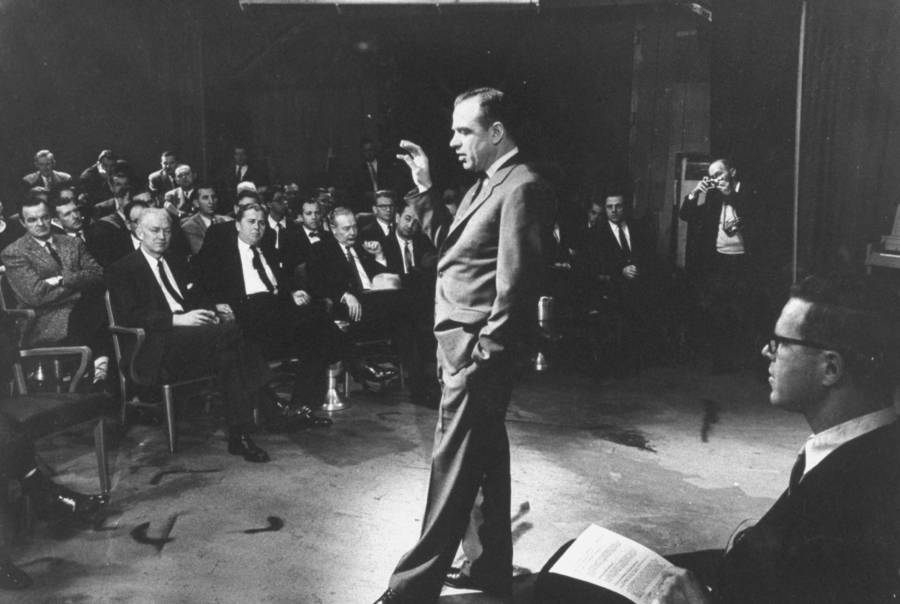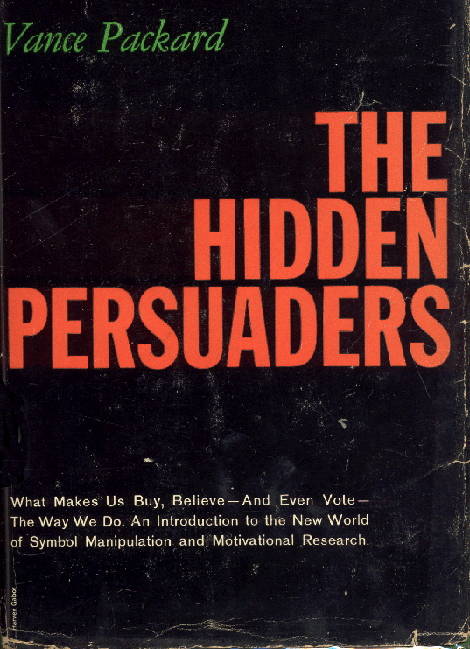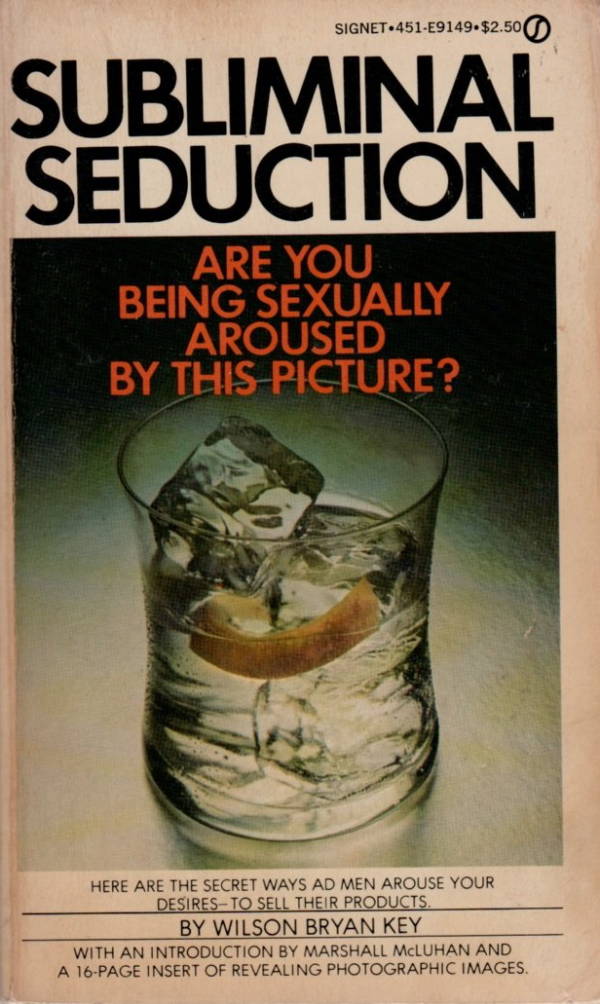What are subliminal messages? Do subliminal messages work? Though everyone from Coca-Cola to Disney has been accused of using these tactics, few of us seem to know the truth about what these messages are and whether or not they're effective.

Walter Daran/The LIFE Images Collection/Getty ImagesStill image from the study that first put subliminal messages on the map in 1957. The researchers claimed to have flashed the words “EAT POPCORN” during a movie showing in hopes of getting people to buy popcorn.
Some say they can control our minds without us even knowing while others say they don’t even exist at all. There are many differing views on the authenticity, power, and purpose of what are known as subliminal messages.
For some, subliminal messages are synonymous with mind control: a form of insidious mental manipulation designed to alter our behavior so that we’ll buy a certain product, vote for a certain political candidate, or become socially re-engineered in some way without our consent or even our knowledge.
But others take a more positive stance, claiming that subliminal messages can be used as self-development tools to reprogram the subconscious mind for success or to change a specific habit that’s holding you back.
But, for starters, do these kinds of messages really exist? And if so, what are subliminal messages and do subliminal messages work?
What Are Subliminal Messages?

Public Domain
To begin with, people often confuse subliminal messages with supraliminal messages. The latter are stimuli or signals that we can see or hear but we are not consciously aware of their impact on our behavior.
In 1999, researchers put these kinds of messages to the test in a British supermarket by changing the store music (the supraliminal stimulus) on alternating days in order to encourage customers to buy either French or German wine. Sure enough, when German music played, German wine outsold French wine, and when French music played, French sales were higher. Questionnaires filled out by shoppers afterward demonstrated that they were aware of the music but unaware of the effect that it seemed to have on their behavior.
Subliminal messages, on the other hand, are likewise real and similar to supraliminal messages except that the signal or stimulus is below our threshold of conscious awareness. In other words, you cannot consciously perceive a subliminal message, even if you search for it.
In terms of visual images, a subliminal message would be flashed across a screen in just a few milliseconds, too small a window for you to be aware of it. For an auditory message, it might be delivered at a frequency below humans’ range of detection or hidden beneath another sound.
The idea is that your conscious mind cannot discern these messages and thus the subliminal directive is absorbed unchallenged into your subconscious where it can influence your thoughts and behavior. If you can consciously discern the message, then it wasn’t subliminal.
What this means is that many so-called subliminal messages reported to appear in movies, advertising, music, and so on that are popular with conspiracy theorists aren’t subliminal at all, but most likely either supraliminal or figments of the viewer or listener’s imagination.
How Paranoia About Subliminal Messages Began

Hank Walker/The LIFE Picture Collection/Getty ImagesJames Vicary addresses the F.C.C. regarding subliminal advertising. 1958.
Subliminal messages first entered the popular consciousness in 1957 when researchers James Vicary and Frances Thayer conducted an experiment that would influence advertising and media — or at least the way the masses felt about those things — for decades to come.
Vicary and Thayer stated that they’d flashed the words “Eat popcorn” and “Drink Coca-Cola” for just 1/3,000 of a second every five seconds to more than 45,000 people during screenings of the movie Picnic over a six-week period. They then reported a jump in popcorn and Coca-Cola sales of 57.5 percent and 18.1 percent respectively during those screenings.
When the news broke, journalists were in an uproar. Norman Cousins of The Saturday Review began his report on the matter with “Welcome to 1984,” a reference to George Orwell’s dystopian novel.

Wikimedia Commons
Soon, Vance Packard’s book The Hidden Persuaders claimed that advertisers were manipulating Americans’ unconscious desires so that they’d buy products they didn’t need. Now, Packard did not use the word “subliminal” in the book and made only a fleeting mention of Vicary and Thayer’s study. Nevertheless, the book became a bestseller, compounding negative public attitudes about subliminal messages.
National alarm bells were sounded. Hearings were held by Congress and the Federal Trade Commission on subliminal messages. But legislation against their use did not pass because it was difficult to legislate against something that could not be consciously seen or heard.
But finally in 1962, after five years of mounting fear and anger about supposed mind control, Vicary made an astonishing announcement: his study was a fake.
He’d never even conducted the experiment and had concocted the whole thing to drum up publicity in order to save his failing marketing business.
But fear regarding subliminal messages long survived Vicary’s fraud. The Federal Communications Commission issued a public notice in 1974 stating that subliminal messages were “contrary to the public interest…[and] intended to be deceptive,” and that those who use them are not protected by the First Amendment (still, there remains no specific federal or state law against subliminal messages in the United States).
Supposed Subliminal Advertising

SignetWilson Bryan Key claimed that the ice cubes on the cover of his book contain the image of a man pulling back his overcoat to expose himself and an older woman, perhaps the man’s mother, scolding her son for this act.
Despite common misconceptions, the advertising world never took much of an interest in subliminal messaging — because they found it didn’t work. Some ad agencies and television networks did research the concept but the results weren’t favorable.
For instance, in February 1958, the Canadian Broadcasting Company tried to see if they could get people to use their phones by flashing the words “Telephone Now” 352 times in a 30-minute broadcast — resulting in no calls.
While researchers failed to prove the effectiveness of subliminal advertising, Canadian sociologist Wilson Bryan Key stoked public paranoia with the publication of his book Subliminal Seduction in 1972. Key claimed that advertisers were using hidden images — mainly sexualized ones, such as phallic symbols — and suggestive words to influence buying habits (something that companies such as Marlboro and Coca-Cola have been accused of).
But John O’Toole, President of the American Association of Advertising Agencies, denied Key’s claims:
“There is no such thing as subliminal advertising. I have never seen an example of it, nor have I ever heard it seriously discussed as a technique by advertising people…Even more absurd is the theory proposed by Wilson Bryan Key…From whatever dark motivations, Key finds sexual symbolism in every ad and commercial.”
And even those who had no stake in the world of advertising denied Key’s widely discredited claims again and again (see below).
Subliminal Messages In Film And Music
In addition to unfounded paranoia about supposed subliminal advertising, the public also grew fearful that there might be subliminal messages in film and music.
Disney, for one, has been repeatedly accused of using sexualized subliminal messages in some of their classic animated films. However, former Disney animator Tom Sito told HuffPost that in most cases what viewers thought they saw or heard was incorrect.
For instance, in a scene from Aladdin (1992), the titular hero appears to say “Good teenagers take off their clothes.” But according to Sito, the real line is, “Good tiger. Take off. Scat. Go!” And in The Lion King (1994), Simba stirs up a dust cloud that appears to form “S-E-X.” But this is merely a misreading of “S-F-X,” which the animators did put in there as a nod to the film’s special effects crew.
But the controversy surrounding Disney may not even compare to the accusations leveled against heavy metal bands who were believed to have inserted subliminal messages about things like Satanism and suicide into their music.
https://www.youtube.com/watch?v=PqAPVB4u9Zs
In 1990, the band Judas Priest found themselves in court when two young men turned a shotgun on themselves after listening to one of the band’s records (above). One of the men died but the other, James Vance, survived.
Vance and his family then sued the band and CBS Records for $6.2 million claiming that subliminal messages of “try suicide,” “do it,” and “let’s be dead” were present in the music and had made the men shoot themselves. Judas Priest denied using subliminal messages (their lead singer quipped that if he’d used them, he would have told his listeners to buy more records) but Wilson Bryan Key testified on behalf of the parents.
However, the judge put no stock in Key’s claims and decided that there was insufficient scientific evidence to “establish that subliminal stimuli, even if perceived, may precipitate conduct of this magnitude.”
Subliminal Self-Help

Pixabay
Despite high-profile cases like the Judas Priest lawsuit, subliminal messages actually came into favor with some in the 1990s. The idea that subliminal messages could reprogram a person’s subconscious mind caused some to turn self-help cassettes and CDs using these messages into big business.
Record labels like California’s Valley of the Sun released hundreds of recordings featuring subliminal messages in the form of positive affirmations embedded below restful New Age music to help listeners do things like overcome addictions, lose weight, choose better eating habits, and increase their confidence.
But even when the messages were intended for good, the science once again showed that they actually had no effect.
A 1991 study by the University of California’s Anthony Pratkanis and colleagues concluded that any positive gains from subliminal self-help were most likely the result of the placebo effect. These results have proven to be consistent with those of subsequent studies time and again.
Do Subliminal Messages Work?
While studies like those above conducted from the 1960s to the 1990s generally discredited subliminal messaging, some more recent research suggests that these messages may have some effect after all, though not to the extent that many long feared — making the question “do subliminal messages work?” not an easy one to answer.
In 2002, a Princeton study showed that participants’ thirst levels increased by 27 percent after they’d experienced subliminal messages (12 images of a Coca-Cola can and 12 frames of the word “thirsty”) that had been inserted into an episode of The Simpsons.
Four years later, researchers from Utrecht University and Radboud University in the Netherlands once again asked “do subliminal messages work?” and conducted a similar experiment in which subjects exposed to subliminal messages experienced not only an increased thirst level but also a tendency to choose a certain beverage. When subliminally primed with the words “Lipton Ice,” participants were more likely to chose Lipton iced tea over the other drink used in the study.
Though these studies suggest that subliminal messages can influence behavior, the effects were largely fleeting and limited to a laboratory setting as opposed to a real-world one.
However, a number of studies have shown subliminal messages to be effective in real-world applications, sometimes with the effect lasting for an extended period of time.
A study conducted in 2007 showed that Israelis were more likely to vote more moderately in a real election if they had been subliminally primed with the Israeli flag beforehand (perhaps confirming fears that some expressed over a George W. Bush campaign ad from 2000 — see above). That same year, another study demonstrated that students exposed subliminally to words related to intelligence performed better in real exams up to four days later.
More recently, studies involving brain scans have shown that subliminal messages can induce measurable physiological effects to the emotional and memory centers of the brain. More surprisingly, subliminal messages correlated with enhanced activity levels were in the insula, the part of the brain involved in conscious awareness.
Although scientific opinion has swung back around to some extent and modern researchers have demonstrated that subliminal messages can influence us to some degree, there is only very little evidence to suggest that they can have lasting, real-world effects.
But still, perhaps those who’d long been paranoid about mind control did have a little something to worry about after all.
What are subliminal messages? Do subliminal messages work? After finding out above, take a look at some unusual mental disorders that will leave you fascinated as well as some appalling sexist ads of decades past.





